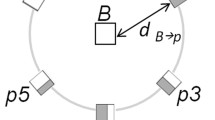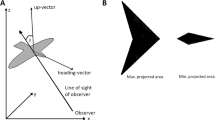Abstract
Thousands of birds flying together at high speeds are able to execute abrupt manoeuvres with such precise coordination that some investigators have postulated that ‘thought transference’1 or electromagnetic communication2 must be taking place. Recently, Davis proposed that coordination is achieved by a ‘threshold’ number of birds executing ‘preliminary movements’ which signal to the flock that a turn is imminent3. Here I show by analysis of film of dunlin (Calidris alpina) flocks that a single bird may initiate a manoeuvre which spreads through the flock in a wave. The propagation of this ‘manoeuvre wave’ begins relatively slowly but reaches mean speeds three times higher than would be possible if birds were simply reacting to their immediate neighbours. These propagation speeds appear to be achieved in much the same way as they are in a human chorus line: individuals observe the approaching manoeuvre wave and time their own execution to coincide with its arrival.
Similar content being viewed by others
References
Selous, E. Thought-transference (or what?) in Birds (Constable, London, 1931).
Heppner, F. H. & Haffner, J. in Biological and Clinical Effects of Low Frequency Magnetic and Electric Fields (eds Llaurado, J. G., Sauces, A. Jr & Battocletti, J. H.) 147–162 (Thomas, Illinois, 1974).
Davis, J. M. Anim. Behav. 28, 668–673 (1980).
Teichner, W. H. Psychol. Bull. 51, 128–149 (1954).
Pomeroy, H. & Heppner, F. Anim. Behav. 25, 720–725 (1977).
Major, P. F. & Dill, L. M. Behavl Ecol. Sociobiol. 4, 111–112 (1978).
Page, G. & Whitacre, D. F. Condor 77, 73–83 (1975).
Rudebeck, G. Oikos 3, 200–231 (1951).
Author information
Authors and Affiliations
Rights and permissions
About this article
Cite this article
Potts, W. The chorus-line hypothesis of manoeuvre coordination in avian flocks. Nature 309, 344–345 (1984). https://doi.org/10.1038/309344a0
Received:
Accepted:
Issue Date:
DOI: https://doi.org/10.1038/309344a0
- Springer Nature Limited
This article is cited by
-
Decentralised coverage of a large structure using flocking of autonomous agents having a dynamic hierarchy model
Autonomous Robots (2022)
-
Collective motion: Influence of local behavioural interactions among individuals
Journal of Biosciences (2022)
-
Causes of variation of darkness in flocks of starlings, a computational model
Swarm Intelligence (2022)
-
A new weighted fuzzy C-means clustering for workload monitoring in cloud datacenter platforms
Cluster Computing (2021)
-
Damping of waves of agitation in starling flocks
Behavioral Ecology and Sociobiology (2019)





